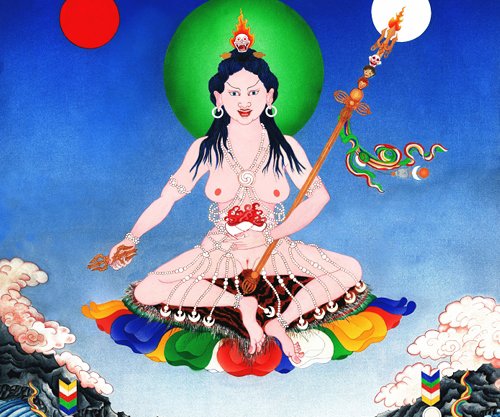This iconographic line drawing was created by Khandro Déchen. PaDampa Sang-gyé (rGya gar dam pa sangs gyas / རྒྱ་གར་དམ་པ་གསངས་གྱས་) was the Consort (sang-yab / gSang yab / གསང་ཡབ་) of Ma-gÇig Labdrön (ma gCig lab sGron / མགཅིག་ལབ་སྒྲོན་ / 1031-1126). PaDampa Sang-gyé is renowned as the Father of Zhi-jé (zhi byed / ཞི་བྱེད) Pacification — as Ma-gÇig Labdrön is the Mother of gÇod (གཅོད་) Cutting.
One of Ngak’chang Rinpoche and Khandro Déchen’s Tsawa’i Lamas——‘Khordong gTérchen Tulku Chhi’mèd Rig’dzin Rinpoche——was Gyalwa Dhöndrüp, the youngest son of Ma-gÇig Labdrön in a previous incarnation——and it was Gyalwa Dhöndrüp who requested from his mother the short Lama’i Naljor (bLa ma’i rNal ‘byor / བླ་མའི་རྣལ་འབྱོར་ / guru yoga) which is practised in Aro gTér and many other lineages.
Chhi’mèd Rig’dzin Rinpoche (‘khor gDong gTer chen sPrul sKu chhi ‘med rig ‘dzin / འཁོར་གདོང་གྟེར་ཆེན་སྤྲུལསྐུ་ཆི་འམེད་རིག་འཛིན་) taught the melody of this Lama’i Naljor to Ngak’chang Rinpoche and Khandro Déchen — and told them: “I can still hear her voice singing this.”
Ngak’chang Rinpoche said “Chhi’mèd Rig’dzin Rinpoche’s Mind-stream was clear throughout his incarnations — and thus there was no distance in time between him having heard the voice of Ma-gÇig Labdrön and us hearing it from him.”
The melody is almost identical in most other lineages — but Chhi’mèd Rig’dzin Rinpoche taught a double-beat in the gÇod damaru rhythm which is particular to his lineage of ‘Khordong gTér.
gÇod, means ‘Cutting’. It is a practice which unites the teachings of Prajnaparamita and the Mahayoga Tantras.
gÇod was originated by the female Tibetan Mahasiddha Ma-gÇig Labdrön and also by Indian Mahasiddha PaDampa Sang-gyé whose tradition was called Zhi-jé (zhi byed / ཞི་བྱེད), one of the Eight Major Practice Lineages.
Khandro Déchen says of this image:
“PaDampa Sang-gyé visited Tibet on several occasions during the 12th century. This image shows him as an Indian mahasiddha in the classical style.
The unusual colour of his body in thangkas is the combination of a dark skin dusted with cremation ash. The ash is also matted with his beard and hair. It is interesting to note that at this time Vajrayana was lived overtly rather than expressed symbolically.”
When practitioners of the gö-kar chang-lo’i dé (gos dKar lCang loi sDe / གོས་དཀར་ལྕང་ལོའི་སྡེ་) practised during the 12th century—and before—they would wear the actual ornaments of the yidam as much as was feasible within the drüpthab (sGrub thab / སྒྲབ་ཐབ་ / sadhana).
Here, Padampa Sang-gyé wears the five skull crown of the tantrika and the tiger hide skirt of the Traktung (khrag ‘thung / ཟཀྲག་འཐུང་).
He sits on the yogic deer-skin mat and wears the cemetery ornaments (ru rGyan / རུས་རྒྱན་).
He carries the implements of gÇod – the kangling (rKang gLing / རྐང་གླིང / human femur trumpet) and skull damaru (thod rnga / ཐོད་རྔ་).
His eyes are wide open in the characteristic Dzogchen gaze.
Khandro Déchen said “Ngak’chang Rinpoche spent some time wandering in the wilds of Chamba practising gÇod – wandering in areas which are no longer accessible. Chamba is a mountainous area beyond Triund, the highest point above McLeod Ganj, in Himachal Pradesh. Ngak’chang Rinpoche learnt Düd‘jom gTér gÇod from Ngakpa Yeshé Dorje and practised the gTröma gÇod a great deal when he was young. He was given his first kangling by Jétsunma Khandro Tendzin Drölkar (rJe bTsun ma mKha’ ‘gto bsTan ‘dzin grol dKar / རྗེ་བཙུན་མ་མཁའ་འགྲོ་བསྟན་འཛི་གྲོ་དཀར་) the wife of Ngakpa Yeshé Dorje as an inspiration. He later gave this kangling to me when he was given another by Kyabjé Künzang Dorje Rinpoche.”
PaDampa Sang-gyé was an incarnation of Guru Rinpoche – as Ma-gÇig Labdrön was an incarnation of Yeshé Tsogyel. Married Lamas of the Nyingma tradition are always regarded by their disciples as manifestations of Padmasambhava and Yeshé Tsogyel.
Together they replicated the dynamism of the first spread of the teachings in Tibet – and as such the teachings of gÇod have proliferated and been absorbed into every school, tradition, and lineage of Buddhism.
Guru Chöwang (gu ru chos dBang, 1212-1270) and Jomo Menmo (jo mo men mo, 1248-1283) were the incarnations of Padampa Sang-gyé and Ma-gÇig Labdrön (and in turn incarnations of Padmasambhava and Yeshé Tsogyel).
Ngak’chang Rinpoche has received teachings of gÇod from the Düdjom gTér, Longchen Nying-thig, Chang gTér, and Khordong gTér systems of the Nyingma tradition, as well as from Kagyüd, and Sakya Schools.
The actual tradition of Zhi-jé is no longer extant but it lives on within every yogic lineage.
In the Aro gTér lineage the practices of sang gÇod and yang-sang gÇod (gSang gCod and yang gSang gCod), that is, secret gÇod and ultimate gÇod, are employed – but the outer and inner liturgical forms do not form part of the gTérma system.








